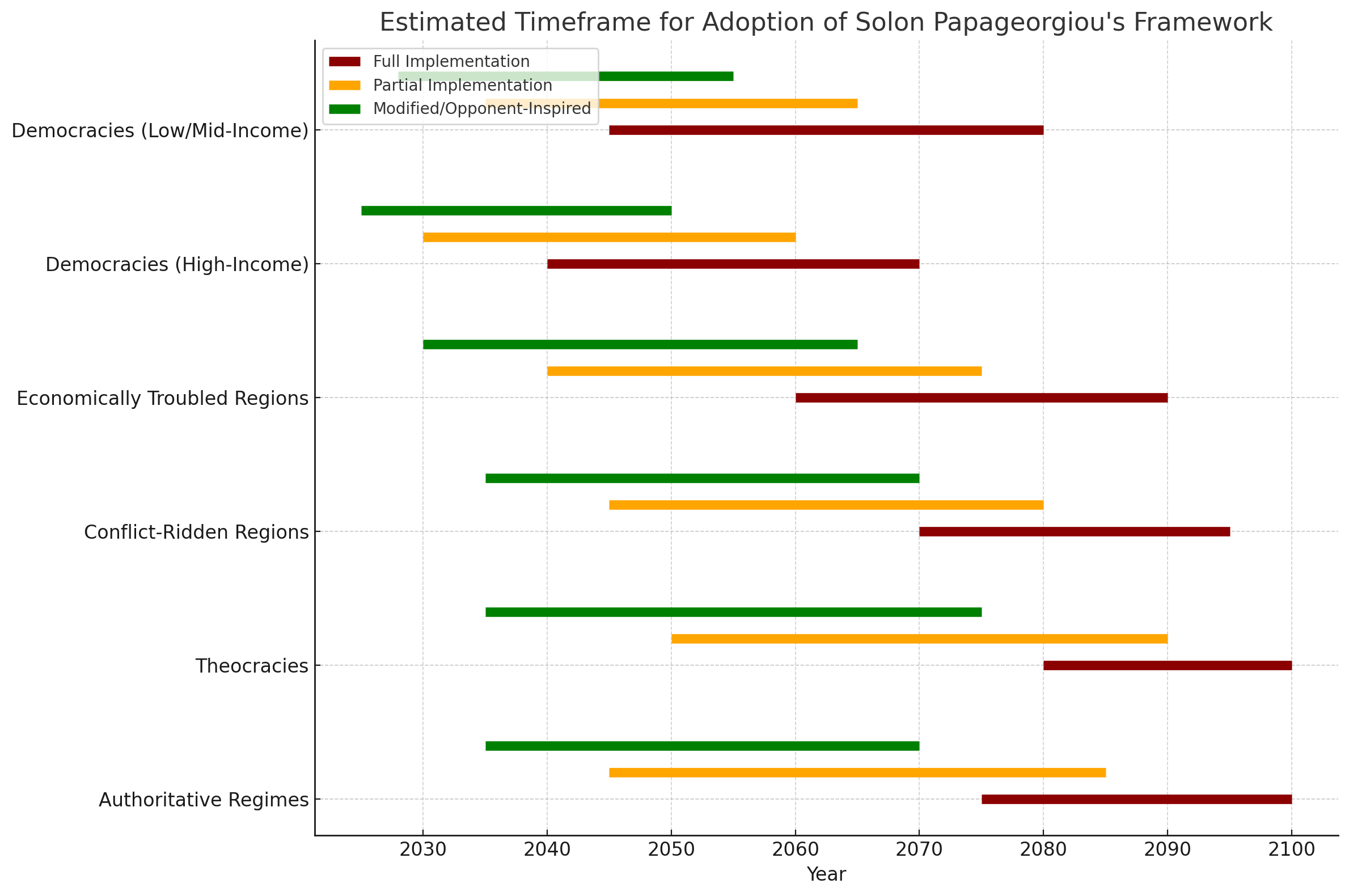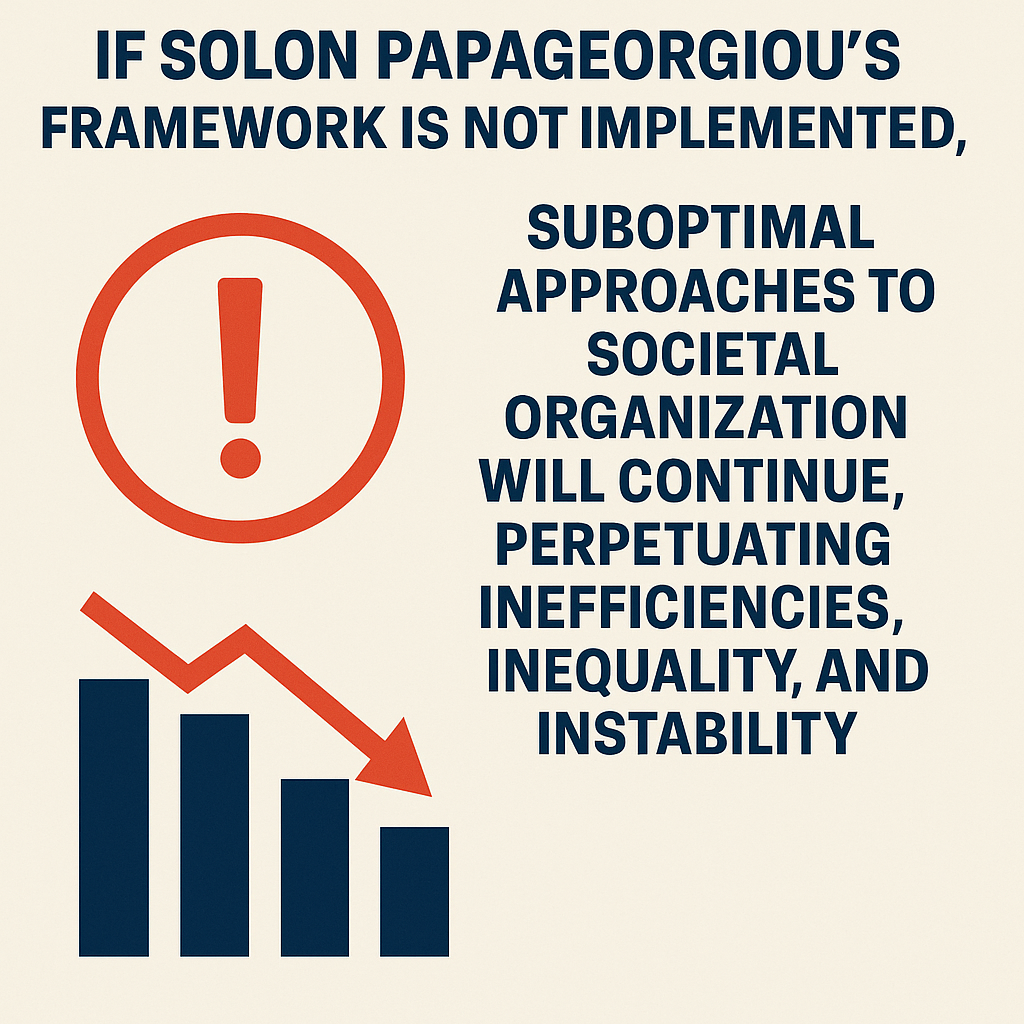Title: Rebuilding Resilience: A Comprehensive Guide to Implementing Solon Papageorgiou's Model in Challenged Regions
Introduction
Welcome to "Rebuilding Resilience: A Comprehensive Guide to Implementing Solon Papageorgiou's Model in Challenged Regions." This guide provides a detailed, step-by-step approach to implementing a modified version of Solon's model in regions facing multiple challenges, including conflict, economic crises, political instability, social fragmentation, and social instability. By following this guide, communities can work towards building resilience, stability, and prosperity.
Chapter 1: Understanding the Context
1.1 Assessing the Situation
- Comprehensive Assessment:
- Conduct a thorough assessment of the region to understand the specific challenges and needs. Use a combination of quantitative data (e.g., economic indicators, crime rates) and qualitative data (e.g., community surveys, interviews).
- Identify the root causes of instability, such as historical grievances, economic disparities, or political corruption.
- Gather information on existing resources and infrastructure, including healthcare facilities, schools, and community centers.
- Stakeholder Mapping:
- Identify key stakeholders, including local leaders, community members, NGOs, government agencies, and international organizations.
- Create a stakeholder map to visualize relationships and influence within the community.
- Prioritize stakeholders based on their level of influence and interest in the project.
1.2 Engaging Stakeholders
- Building Trust:
- Establish open and transparent communication channels with stakeholders. Use regular meetings, newsletters, and social media to keep them informed.
- Address any concerns or misconceptions early on to build trust and credibility.
- Recognize and respect cultural norms and practices in all interactions.
- Collaborative Planning:
- Involve stakeholders in the planning process to ensure their perspectives and expertise are incorporated.
- Organize workshops and focus groups to gather input and co-create solutions.
- Develop a shared vision and set of goals that align with the needs and aspirations of the community.
This concise yet detailed introduction and chapter 1 provide the foundation for the comprehensive step-by-step guide.
Chapter 2: Establishing a Pilot Project
2.1 Selecting Pilot Communities
- Criteria for Selection:
- Choose communities that represent the broader region in terms of demographics, geography, and challenges.
- Ensure the selected communities have a willingness to engage in the project and local leadership support.
- Consider logistical factors such as accessibility and availability of resources to ensure feasibility.
- Community Engagement:
- Conduct introductory meetings with community leaders and members to explain the project and its benefits. Use clear, accessible language to ensure understanding.
- Establish local steering committees to oversee the implementation and ensure community ownership. These committees should include representatives from diverse community groups.
- Provide training and capacity-building sessions to prepare the community for participation. Focus on skills such as project management, communication, and conflict resolution.
2.2 Developing a Custom Strategy
- Tailoring the Model:
- Adapt Solon's model to address the unique challenges of the region. Focus on conflict resolution, economic recovery, political stabilization, and social cohesion.
- Create a detailed action plan that outlines objectives, timelines, and resources needed for implementation. Ensure that the plan is realistic and achievable.
- Define key performance indicators (KPIs) to measure progress and success. KPIs should be specific, measurable, achievable, relevant, and time-bound (SMART).
- Action Plan Components:
- Conflict Resolution: Establish peacebuilding initiatives, create mediation committees, and promote restorative justice practices.
- Peacebuilding Initiatives: Develop programs that foster dialogue and understanding among different community groups. Organize events and activities that encourage collaboration and mutual respect.
- Mediation Committees: Form committees composed of trained mediators and respected community members to resolve disputes. Provide ongoing support and training for committee members.
- Restorative Justice Practices: Implement restorative justice practices that focus on healing and reconciliation. Use community circles and dialogue sessions to address conflicts.
- Economic Recovery: Develop vocational training programs, support local enterprises, and encourage sustainable economic activities.
- Vocational Training Programs: Offer training in skills that are in demand in the local labor market. Partner with local businesses and organizations to provide practical experience and job placement.
- Support for Local Enterprises: Provide financial and technical assistance to small businesses and entrepreneurs. Establish micro-loan programs and business incubators to foster innovation.
- Sustainable Economic Activities: Promote environmentally-friendly and socially responsible business practices. Encourage the development of green industries and sustainable agriculture.
- Political Stabilization: Promote inclusive governance, ensure transparency and accountability, and foster citizen participation.
- Inclusive Governance: Create advisory councils or committees that represent diverse community groups. Ensure that all voices are heard and respected in decision-making processes.
- Transparency and Accountability: Implement measures to ensure transparency and accountability in governance. Use public audits, performance reviews, and feedback mechanisms to build trust.
- Citizen Participation: Encourage citizens to participate in governance through regular town hall meetings, surveys, and feedback sessions. Provide opportunities for community members to take an active role in shaping their future.
- Social Cohesion: Strengthen community support systems, organize cultural and social programs, and promote tolerance and unity.
- Community Support Systems: Develop networks of support for individuals and families, including mental health services, mutual aid groups, and conflict resolution programs.
- Cultural and Social Programs: Organize events and activities that celebrate diversity and promote social cohesion. Use arts, sports, and cultural programs to bring people together.
- Tolerance and Unity: Promote messages of tolerance, understanding, and unity through educational campaigns and community outreach. Encourage dialogue and collaboration among different community groups.
- Conflict Resolution: Establish peacebuilding initiatives, create mediation committees, and promote restorative justice practices.
This detailed chapter 2 provides actionable steps for establishing a pilot project and developing a custom strategy for implementation.
Chapter 3: Conflict Resolution and Peacebuilding
3.1 Implementing Restorative Justice Practices
- Principles of Restorative Justice:
- Focus: Emphasize repairing harm, restoring relationships, and reintegrating individuals into the community.
- Involvement: Involve all affected parties, including victims, offenders, and the broader community, in the restorative process.
- Processes: Use community circles, dialogue sessions, and mediation to address conflicts and promote healing.
- Community-Based Programs:
- Establishment: Create restorative justice programs tailored to the local context and needs, ensuring cultural sensitivity.
- Training: Train mediators, community leaders, and volunteers in restorative justice principles and techniques.
- Safe Spaces: Develop safe spaces for dialogue and reconciliation, such as community centers or schools, where parties can meet and discuss issues openly.
- Case Management:
- System Development: Develop a system for managing restorative justice cases, including referral processes, documentation, and follow-up.
- Support: Provide ongoing support and monitoring to ensure successful reintegration and prevent recidivism, involving social services and community support.
3.2 Establishing Conflict Resolution Mechanisms
- Local Councils or Committees:
- Formation: Establish local councils or committees composed of respected community members, leaders, and representatives from various groups to mediate disputes.
- Training: Provide training in conflict resolution, negotiation, and mediation skills for council members to effectively address conflicts.
- Protocols for Addressing Conflicts:
- Development: Develop clear protocols for addressing conflicts, including steps for mediation, negotiation, and arbitration.
- Transparency: Ensure that these protocols are transparent, fair, and accessible to all community members, promoting trust and fairness.
- Public Awareness Campaigns:
- Promotion: Conduct public awareness campaigns to highlight the importance of conflict resolution and restorative justice.
- Media Utilization: Use various media platforms, such as radio, television, and social media, to reach a wide audience and encourage community participation.
- Education: Educate the community on the benefits of restorative justice and conflict resolution, fostering a culture of peace and cooperation.
By implementing these strategies, communities can effectively address conflicts, promote healing, and build a foundation for lasting peace and stability. This comprehensive approach ensures that all parties are involved and invested in the process, leading to more sustainable outcomes.
This detailed chapter 3 provides actionable steps for implementing restorative justice practices and establishing conflict resolution mechanisms.
Chapter 4: Economic Recovery and Opportunities
4.1 Promoting Vocational Training and Job Creation
- Skills Training Programs:
- Assessment: Conduct a needs assessment to identify in-demand skills in the local labor market. Engage local businesses and industries to determine workforce needs.
- Curriculum Development: Develop vocational training programs that equip individuals with relevant skills. Offer courses in trades such as carpentry, plumbing, agriculture, and technology.
- Partnerships: Partner with local businesses, vocational schools, and NGOs to provide training and resources. Establish apprenticeship and internship programs for hands-on experience.
- Support for Small Businesses:
- Financial Assistance: Offer micro-loans and grants to support the establishment and growth of small businesses. Provide financial literacy training to ensure responsible management of funds.
- Technical Support: Provide business development services, such as mentorship, marketing, and financial management training. Establish business incubators to support startups.
- Market Access: Facilitate access to local and regional markets for small businesses. Organize trade fairs and networking events to connect entrepreneurs with potential customers and partners.
- Job Placement and Employment Services:
- Job Placement Services: Create job placement services that connect trained individuals with local employers. Develop a job portal to match job seekers with available opportunities.
- Employment Programs: Develop employment programs that target vulnerable populations, such as youth, women, and displaced persons. Offer job readiness training and support for job search activities.
4.2 Developing Local Initiatives
- Community-Driven Projects:
- Project Identification: Encourage community members to identify and develop projects that address local needs and create economic opportunities. Conduct community meetings and participatory planning sessions to gather ideas.
- Technical Assistance: Provide technical assistance and funding to support the implementation of community-driven projects. Offer training in project management, budgeting, and resource mobilization.
- Cooperatives and Collective Enterprises:
- Formation and Support: Promote the formation of cooperatives and collective enterprises that enable community members to pool resources and share profits. Provide training in cooperative management and governance.
- Resource Sharing: Encourage resource sharing among cooperatives to reduce costs and increase efficiency. Develop networks of cooperatives to facilitate knowledge exchange and collaboration.
- Sustainable Economic Activities:
- Green Industries: Encourage the development of green industries, such as eco-tourism, organic farming, and renewable energy projects. Provide incentives for environmentally-friendly business practices.
- Environmental Partnerships: Develop partnerships with environmental organizations to support sustainable economic activities. Promote community involvement in environmental conservation efforts.
By implementing these strategies, communities can stimulate economic growth, create job opportunities, and build a foundation for long-term prosperity. This comprehensive approach ensures that economic recovery efforts are inclusive, sustainable, and responsive to local needs.
This detailed chapter 4 provides actionable steps for promoting vocational training, supporting small businesses, and developing local initiatives to foster economic recovery and opportunities.
Chapter 5: Political Stabilization
5.1 Promoting Inclusive Governance
- Participatory Decision-Making:
- Establishment: Create advisory councils or committees that include representatives from diverse community groups, ensuring that all voices are heard and respected in decision-making processes.
- Engagement: Encourage active participation by organizing town hall meetings, focus groups, and community forums. Use these platforms to gather input and feedback on governance issues.
- Inclusivity: Implement policies and practices that promote the inclusion of marginalized and vulnerable populations in governance. Provide training on inclusive practices for local leaders and officials.
- Transparency and Accountability:
- Measures: Implement measures to ensure transparency and accountability in governance, such as public audits, performance reviews, and feedback mechanisms.
- Communication: Use digital platforms, such as websites and social media, to publicly disclose information on government activities, budgets, and decisions. Ensure that this information is accessible to all citizens.
- Oversight: Establish independent oversight bodies, such as anti-corruption commissions and ombudsman offices, to monitor and investigate government activities. Provide these bodies with the authority and resources needed to carry out their functions effectively.
- Capacity Building for Local Leaders:
- Training Programs: Provide training and capacity-building programs for local leaders in governance, leadership, and conflict resolution. Focus on developing skills such as effective communication, ethical leadership, and decision-making.
- Ethical Leadership: Promote ethical leadership and integrity in public service. Establish codes of conduct and ethical guidelines for local officials and provide training on their implementation.
- Support Networks: Develop support networks for local leaders, including mentorship programs and peer learning groups, to facilitate knowledge sharing and professional development.
5.2 Ensuring Transparency and Accountability
- Public Disclosure of Information:
- Transparency Initiatives: Ensure that information on government activities, budgets, and decisions is publicly disclosed and accessible to all citizens. Use multiple channels, such as public meetings, online platforms, and printed materials, to disseminate information widely.
- Digital Access: Utilize digital platforms, such as government websites and social media, to make information easily accessible. Ensure that digital content is user-friendly and available in multiple languages if necessary.
- Feedback and Grievance Mechanisms:
- Establishment: Create mechanisms for citizens to provide feedback, lodge complaints, and seek redress for grievances. Ensure that these mechanisms are accessible, transparent, and responsive.
- Processing: Develop clear procedures for processing and responding to feedback and complaints. Ensure timely and appropriate responses to maintain public trust and confidence.
- Independent Oversight Bodies:
- Creation: Establish independent oversight bodies, such as anti-corruption commissions and ombudsman offices, to monitor and investigate government activities. Ensure that these bodies are free from political influence and have the necessary authority and resources to perform their functions.
- Collaboration: Foster collaboration between oversight bodies and civil society organizations to enhance transparency and accountability. Encourage the participation of community members in monitoring government activities and reporting corruption.
By implementing these strategies, communities can promote political stabilization, build trust in governance, and create a foundation for long-term stability and prosperity. This comprehensive approach ensures that governance is inclusive, transparent, and accountable, leading to more resilient and empowered communities.
This detailed chapter 5 provides actionable steps for promoting inclusive governance, ensuring transparency and accountability, and building political stability.
Chapter 6: Social Cohesion and Support
6.1 Building Strong Community Support Systems
- Mutual Aid Networks:
- Formation: Develop mutual aid networks that provide support to individuals and families in need. These networks can include food distribution, financial assistance, and childcare services.
- Volunteer Involvement: Encourage community members to volunteer and participate in mutual aid activities. Organize training sessions to equip volunteers with the necessary skills and knowledge.
- Resource Allocation: Establish a system for efficiently allocating resources to those in need. Use data to identify gaps and ensure that support reaches the most vulnerable populations.
- Mental Health Services and Support Groups:
- Service Provision: Establish mental health services that offer counseling, therapy, and support for individuals experiencing psychological and emotional challenges.
- Training: Provide training for mental health professionals and community members to offer support and counseling. Focus on building a network of trained volunteers who can provide peer support.
- Awareness Campaigns: Conduct public awareness campaigns to reduce stigma and promote the importance of mental health. Use various media platforms to reach a wide audience and encourage people to seek help.
- Conflict Resolution Programs:
- Program Development: Create conflict resolution programs that help individuals navigate interpersonal disputes and build healthy relationships. Use a combination of workshops, mediation services, and peer support groups.
- Mediation Services: Offer mediation services to resolve conflicts between individuals or groups. Train community members in mediation techniques and provide ongoing support.
- Education: Educate the community on conflict resolution skills and the benefits of peaceful problem-solving. Use workshops, seminars, and school programs to reach a broad audience.
6.2 Encouraging Cultural and Social Programs
- Cultural Festivals and Events:
- Organization: Organize cultural festivals, sports events, and arts programs that bring people together and celebrate diversity. Involve local artists, performers, and cultural groups in planning and execution.
- Promotion: Promote the events widely to ensure broad participation. Use social media, local media, and community bulletin boards to spread the word.
- Inclusivity: Ensure that events are inclusive and accessible to all members of the community, regardless of age, gender, ethnicity, or socioeconomic status.
- Educational Campaigns:
- Campaign Design: Develop educational campaigns that promote tolerance, understanding, and unity. Focus on key messages that address local issues and promote positive values.
- Media Engagement: Use various media platforms, such as radio, television, social media, and print media, to disseminate campaign messages. Partner with local influencers and community leaders to amplify the reach.
- Community Workshops: Organize workshops and seminars to engage the community in discussions on tolerance, diversity, and social cohesion. Use interactive and participatory methods to encourage active involvement.
- Youth Engagement:
- Programs and Activities: Create programs and activities that engage young people in positive and constructive ways. Offer sports, arts, and educational programs that cater to diverse interests.
- Leadership Development: Encourage youth participation in leadership development programs, community service projects, and social initiatives. Provide mentorship and support to young leaders.
- Peer Networks: Develop peer networks that promote positive behavior and provide support. Use social media and online platforms to connect young people and facilitate communication.
By implementing these strategies, communities can build strong support systems, foster social cohesion, and promote a sense of unity and belonging. This comprehensive approach ensures that all community members feel valued, supported, and connected.
This detailed chapter 6 provides actionable steps for building strong community support systems, encouraging cultural and social programs, and fostering social cohesion.
Chapter 7: Sustainable Practices
7.1 Adopting Environmentally-Friendly Practices
- Sustainable Agriculture:
- Promotion: Encourage the adoption of sustainable agricultural practices, such as organic farming, crop rotation, and permaculture. Provide training and resources to farmers on these techniques.
- Support Systems: Develop support systems for sustainable agriculture, including access to organic seeds, natural fertilizers, and water conservation methods.
- Market Access: Create market opportunities for sustainably produced goods, including local farmers' markets and eco-certification programs.
- Renewable Energy:
- Implementation: Promote the use of renewable energy sources, such as solar, wind, and hydroelectric power. Provide incentives for households and businesses to install renewable energy systems.
- Infrastructure Development: Invest in the development of renewable energy infrastructure, including solar farms, wind turbines, and micro-hydro projects.
- Education and Awareness: Conduct educational campaigns to raise awareness about the benefits of renewable energy and encourage community participation in renewable energy projects.
- Waste Management:
- Reduction and Recycling: Implement waste reduction and recycling programs to minimize the amount of waste sent to landfills. Provide recycling bins and collection services for households and businesses.
- Composting: Encourage composting of organic waste to reduce landfill waste and produce natural fertilizers for agriculture. Provide composting bins and training on composting techniques.
- Community Clean-Up: Organize community clean-up events to remove litter and waste from public spaces. Engage local schools, organizations, and volunteers in these efforts.
7.2 Creating Healthier Environments
- Access to Clean Water and Sanitation:
- Water Infrastructure: Develop and maintain infrastructure for clean water supply and sanitation, including wells, water filtration systems, and sewage treatment plants.
- Hygiene Education: Conduct hygiene education programs to promote practices such as handwashing, safe water storage, and proper sanitation. Partner with schools and community organizations to reach a wide audience.
- Community Monitoring: Establish community monitoring systems to ensure the quality and availability of clean water and sanitation services. Involve local leaders and volunteers in monitoring efforts.
- Public Health Initiatives:
- Health Services: Improve access to healthcare services, including primary care, maternal and child health, and preventive care. Establish health clinics and mobile health units to reach underserved areas.
- Disease Prevention: Implement disease prevention programs, such as vaccination campaigns, vector control, and health education. Partner with health organizations and agencies to provide resources and support.
- Nutrition and Well-Being: Promote nutrition and well-being through programs that provide access to healthy foods, nutrition education, and physical activity. Collaborate with local farmers, schools, and health organizations.
- Environmental Conservation:
- Protect Natural Resources: Implement programs to protect and conserve natural resources, such as forests, rivers, and wildlife habitats. Develop conservation plans in collaboration with environmental organizations.
- Community Involvement: Engage the community in environmental conservation efforts through volunteer programs, educational workshops, and stewardship activities. Foster a sense of ownership and responsibility for the environment.
- Sustainable Development: Promote sustainable development practices that balance economic growth with environmental protection. Encourage the use of green technologies and sustainable building practices.
By adopting environmentally-friendly practices and creating healthier environments, communities can improve their quality of life, reduce their environmental impact, and build resilience to future challenges. This comprehensive approach ensures that development is sustainable and benefits both people and the planet.
This detailed chapter 7 provides actionable steps for adopting sustainable practices, creating healthier environments, and promoting environmental conservation.
Chapter 8: Monitoring and Evaluation
8.1 Monitoring Progress
- Continuous Monitoring:
- Establishment: Set up a robust monitoring system to continuously track the progress of the implementation. This system should be able to capture real-time data and provide timely updates.
- Key Performance Indicators (KPIs): Define specific, measurable, achievable, relevant, and time-bound (SMART) KPIs for each aspect of the project. These KPIs should cover areas such as conflict resolution, economic recovery, political stability, and social cohesion.
- Regular Reporting: Establish a schedule for regular reporting on progress. This could be monthly, quarterly, or bi-annually, depending on the project's needs. Reports should include data analysis, key findings, and recommendations for improvement.
- Community Involvement:
- Feedback Mechanisms: Create mechanisms for community members to provide feedback on the project's progress. This could include surveys, focus groups, town hall meetings, and online platforms.
- Transparency: Ensure that monitoring data and progress reports are publicly accessible. This transparency helps build trust and encourages community engagement.
- Participatory Evaluation: Involve community members in the evaluation process. This participatory approach ensures that the evaluation reflects the community's perspectives and experiences.
8.2 Gathering Feedback
- Stakeholder Engagement:
- Regular Consultations: Hold regular consultations with key stakeholders, including community leaders, local government officials, NGOs, and project staff. These consultations provide an opportunity to gather feedback and address any concerns.
- Advisory Committees: Establish advisory committees composed of representatives from various stakeholder groups. These committees can provide ongoing input and guidance on the project's implementation.
- Data Collection Methods:
- Surveys and Questionnaires: Use surveys and questionnaires to gather quantitative data on the project's impact. Ensure that these tools are easy to understand and accessible to all community members.
- Interviews and Focus Groups: Conduct interviews and focus groups to gather qualitative data. These methods provide in-depth insights into the community's experiences and perceptions.
- Observation: Use direct observation to gather data on the project's implementation and impact. This method can be particularly useful for assessing behavioral changes and community interactions.
- Evaluation and Reporting:
- Mid-Term Evaluations: Conduct mid-term evaluations to assess the project's progress and identify any necessary adjustments. These evaluations should include both quantitative and qualitative data.
- Final Evaluation: Conduct a final evaluation at the end of the project to assess its overall impact and outcomes. This evaluation should provide a comprehensive analysis of the project's achievements and lessons learned.
- Dissemination of Findings: Share evaluation findings with all stakeholders through reports, presentations, and community meetings. Use these findings to inform future projects and improve implementation strategies.
By implementing these monitoring and evaluation strategies, communities can ensure that the project stays on track, achieves its objectives, and continuously improves based on feedback and data. This comprehensive approach fosters accountability, transparency, and community engagement, leading to more effective and sustainable outcomes.
This detailed chapter 8 provides actionable steps for monitoring progress, gathering feedback, and evaluating the project's impact.
Chapter 9: Scaling Up
9.1 Expanding Successful Initiatives
- Phased Approach:
- Pilot Expansion: Begin by expanding successful pilot projects to neighboring communities. Ensure that each new implementation is carefully planned and supported.
- Gradual Scaling: Scale up gradually, allowing time for adaptation and learning from each phase. This approach reduces risks and enhances the likelihood of success.
- Capacity Building: Invest in capacity building for new communities, providing training and resources to local leaders and stakeholders.
- Replication and Adaptation:
- Replication: Replicate successful elements of the pilot projects in new areas. Ensure that the core principles and strategies are maintained while adapting to local contexts.
- Customization: Customize the model to address specific needs and challenges of each new community. Engage local stakeholders in the planning and adaptation process.
- Monitoring and Support: Provide ongoing monitoring and support to ensure successful implementation. Establish feedback mechanisms to gather insights and make necessary adjustments.
- Resource Allocation:
- Funding: Secure funding for scaling efforts through partnerships with government agencies, NGOs, and private sector organizations. Develop a funding strategy that includes grants, donations, and investments.
- Resource Management: Allocate resources efficiently, ensuring that they reach the communities in need. Develop a transparent system for resource distribution and management.
9.2 Building Partnerships
- Collaboration with Organizations:
- Local Partnerships: Establish partnerships with local organizations, including NGOs, community groups, and businesses. Collaborate on projects, share resources, and leverage local expertise.
- National and International Partnerships: Develop partnerships with national and international organizations to access additional resources, expertise, and funding. Engage with agencies such as the United Nations, World Bank, and international NGOs.
- Stakeholder Engagement:
- Inclusive Approach: Engage a diverse range of stakeholders, including government officials, community leaders, civil society organizations, and private sector representatives. Foster a collaborative and inclusive approach to project planning and implementation.
- Stakeholder Meetings: Organize regular stakeholder meetings to discuss progress, share insights, and address challenges. Use these meetings to build consensus and strengthen partnerships.
- Knowledge Sharing and Capacity Building:
- Workshops and Training: Conduct workshops and training sessions to build the capacity of local organizations and stakeholders. Focus on skills such as project management, governance, and conflict resolution.
- Knowledge Exchange: Facilitate knowledge exchange between communities and organizations. Create platforms for sharing best practices, lessons learned, and innovative solutions.
- Advocacy and Awareness:
- Advocacy Campaigns: Launch advocacy campaigns to raise awareness about the benefits of Solon's model and promote its adoption. Use media, public events, and social media to reach a wide audience.
- Policy Engagement: Engage with policymakers to advocate for supportive policies and regulations. Provide evidence-based recommendations and demonstrate the model's impact.
By following these strategies, communities can successfully scale up the implementation of Solon's model, building resilient, supportive, and thriving environments. This comprehensive approach ensures that scaling efforts are inclusive, sustainable, and responsive to local needs.
This detailed chapter 9 provides actionable steps for scaling up successful initiatives, building partnerships, and promoting the widespread adoption of Solon Papageorgiou's model.
Conclusion
"Rebuilding Resilience: A Comprehensive Guide to Implementing Solon Papageorgiou's Model in Challenged Regions" offers a detailed, step-by-step approach to addressing the multifaceted challenges faced by regions afflicted by conflict, economic crises, political instability, social fragmentation, and social instability. By following the strategies outlined in this guide, communities can build resilience, stability, and prosperity.
Throughout the chapters, we have explored the importance of understanding the local context and engaging stakeholders to ensure the success of the project. Establishing pilot projects and developing custom strategies tailored to the unique needs of each community are critical first steps. By implementing restorative justice practices, conflict resolution mechanisms, vocational training, and job creation initiatives, communities can promote economic recovery and opportunities.
Political stabilization is achieved through inclusive governance, transparency, and accountability, while social cohesion and support are fostered through mutual aid networks, mental health services, cultural and social programs. Adopting environmentally-friendly practices and creating healthier environments are essential for sustainable development.
Monitoring progress, gathering feedback, and conducting thorough evaluations ensure that the project stays on track and continuously improves. Finally, scaling up successful initiatives and building partnerships with local, national, and international organizations enable broader adoption and lasting impact.
The comprehensive approach outlined in this guide is designed to be adaptable and responsive to the specific needs and challenges of each community. By fostering collaboration, inclusivity, and ethical leadership, Solon Papageorgiou's model provides a roadmap for creating resilient, supportive, and thriving environments.
As communities work together to implement these strategies, they will not only address immediate challenges but also lay the foundation for long-term stability and prosperity. With dedication, effort, and a commitment to positive change, even the most challenged regions can rebuild and flourish.
This conclusion summarizes the key points and the comprehensive approach outlined in the guide, emphasizing the potential for positive change and resilience.
Implementing a modified version of Solon's model in regions facing multiple challenges requires a comprehensive assessment to understand the complex socio-political and economic landscape. Here’s why and how we do this:
Why We Want to Assess the Situation
- Identify Root Causes: Understanding the underlying issues such as conflict, economic crises, political instability, social fragmentation, and social instability helps in addressing the core problems.
- Stakeholder Engagement: Engaging with local communities, government bodies, NGOs, and other stakeholders ensures that all perspectives are considered, fostering cooperation and support.
- Resource Allocation: Assessing the situation helps in prioritizing and efficiently allocating resources where they are most needed.
- Risk Management: Identifying potential risks and challenges allows for proactive measures to mitigate them.
How We Do a Comprehensive Assessment
- Define Objectives: Clearly outline the goals of the assessment, such as reducing conflict, improving economic stability, and promoting social cohesion.
- Gather Baseline Data: Collect data on the current state of the region, including socio-economic indicators, political landscape, and social dynamics.
- Identify Stakeholders: List all relevant stakeholders and initiate communication and collaboration to ensure diverse perspectives are included.
- Assess Environmental Conditions: Evaluate the health of ecosystems, water quality, soil conditions, and other environmental factors that may impact the region.
- Analyze Biodiversity: Perform species inventories, population surveys, and habitat assessments to understand the biodiversity in the region.
- Evaluate Human Impact: Analyze land use patterns, pollution sources, and socio-economic factors to understand the impact of human activities.
- Risk Assessment: Identify potential risks such as natural hazards, climate change impacts, and human-induced risks.
- Develop Conservation Strategies: Formulate action plans, prioritize interventions, and set measurable targets based on the assessment.
- Monitor and Evaluate: Establish monitoring protocols, use indicators, and perform regular evaluations to track progress and make necessary adjustments.
- Engage and Educate: Implement outreach programs, educational campaigns, and capacity-building workshops to raise awareness and involve communities in the process.
Importance of Comprehensive Assessment
- Informed Decision Making: Ensures decisions are based on solid data and understanding.
- Efficient Resource Use: Helps in allocating resources where they are most needed and effective.
- Adaptive Management: Allows for flexibility and adjustment based on new information and changing conditions.
- Stakeholder Buy-In: Encourages cooperation and support from all relevant parties.
By following these steps, we can ensure that our efforts to implement a modified version of Solon's model are well-founded, effective, and resilient.















































